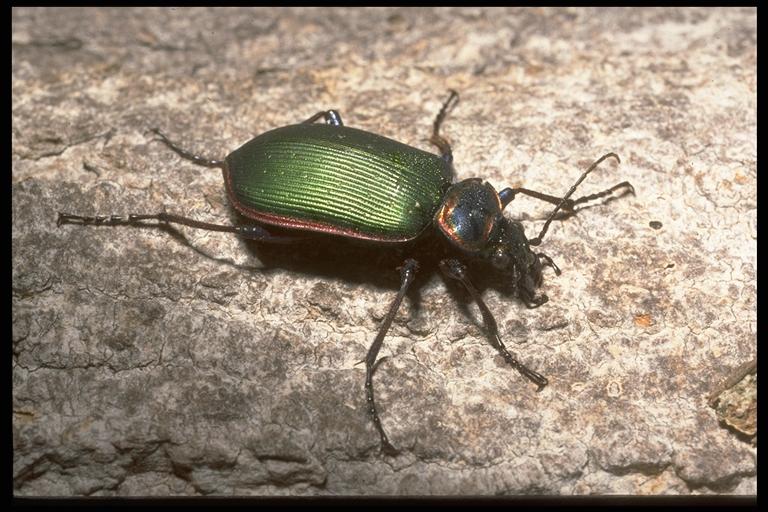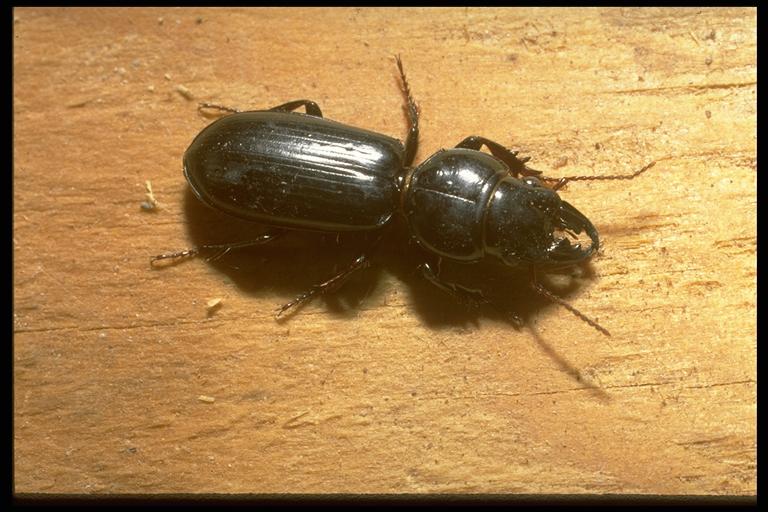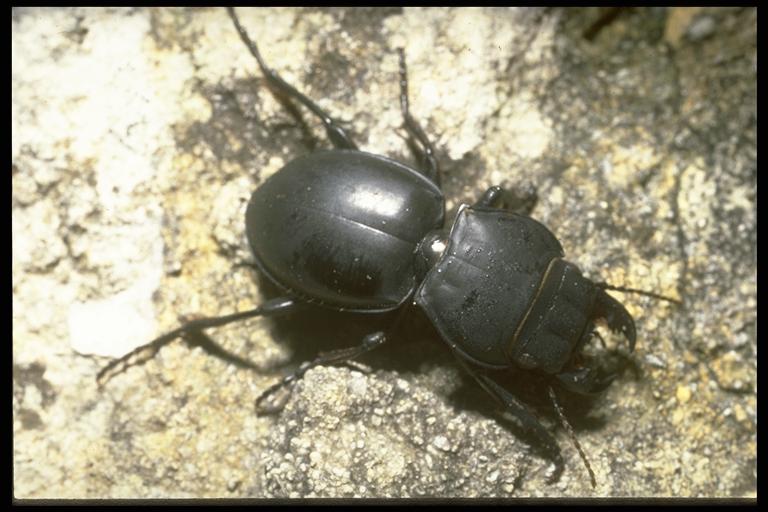
Caterpillar hunter, Calosoma scrutator (Fabricius) (Coleoptera: Carabidae). Photo by Drees.
Common Name: Ground beetle
Scientific Name: Varies
Order: Coleoptera
Description: This group of beetles varies in size (1/8 to 1 inch), shape and color. Most are flattened, dark brown, hard-bodied beetles with many fine lengthwise ridges on their wing covers (elytra). The width of the segment just behind the head (prothorax) is usually narrower than the abdomen. The head is narrower than the prothorax, bearing sickle-like jaws (mandibles) and 11-segmented antennae. Some ground beetles are metallic green or blue or are marked with spots of metallic red or gold. One of the most striking ground beetles is the caterpillar hunter, Calosoma scrutator (Fabricius). This beetle is about 1 inch long and brilliant metallic green. Ground beetle larvae have bodies 3/8 to 1-3/4 inch long, slightly flattened, cream to brown in color, and slightly tapered at each end. They have three pairs of well-developed legs and run quickly. The heads bear sickle-shaped jaws (mandibles) that are pointed forward.

Ground beetle, Scarites subterraneus Fabricius (Coleoptera: Carabidae). Photo by Drees.
One ground beetle species, Scarites subterraneus (Fabricius), is unusual because it has a wide, flat head and prothorax and a narrow, articulated “waist” between the prothorax and abdomen. This species superficially resembles a male stag beetle (Coleoptera: Lucanidae). However, stag beetles have a clubbed antennae, lack the narrow waist and they have smooth wing covers (elytra). The seedcorn beetle, Stenolophus lecontei (Chaudoir), is a smaller (1/3 inch long) dark brown, striped species that occasionally feeds on corn seeds and seedlings.
Life Cycle: Winter is spent in the larva or adult stage. Adults emerge to mate and disperse. Eggs are laid singly in soil. Larvae hatch from eggs and develop through several stages (instars) before pupating. Development is usually complete in one year.

A ground beetle, Pasimachus sp. (Coleoptera: Cicindelidae). Photo by Jackman.
Habitat and Food Source(s): Mouthparts are for chewing. Ground beetles are commonly encountered under stones, bark, logs and other debris laying on the ground. When disturbed, they run rapidly. At night they seek prey and some species are attracted to lights. Larvae are also encountered under objects or in burrows in the soil or under bark of trees. They feed on other insects both as larvae and adults. One group of species feeds on snails. Adults can be collected at lights at night or found underneath stones and other objects on the ground. Larvae may also be found underneath debris.
Pest Status: Species in this highly variable group of beetles are predominantly predators of other arthropods, both as adults and larvae; occasionally become a nuisance when they occur locally in high numbers; although capable of biting, they are generally not medically harmful.
Management: None, this is considered a beneficial insect.
For additional information, contact your local Texas A&M AgriLife Extension Service agent or search for other state Extension offices.
Literature: Borror et al. 1989; Brook et al. 1982.